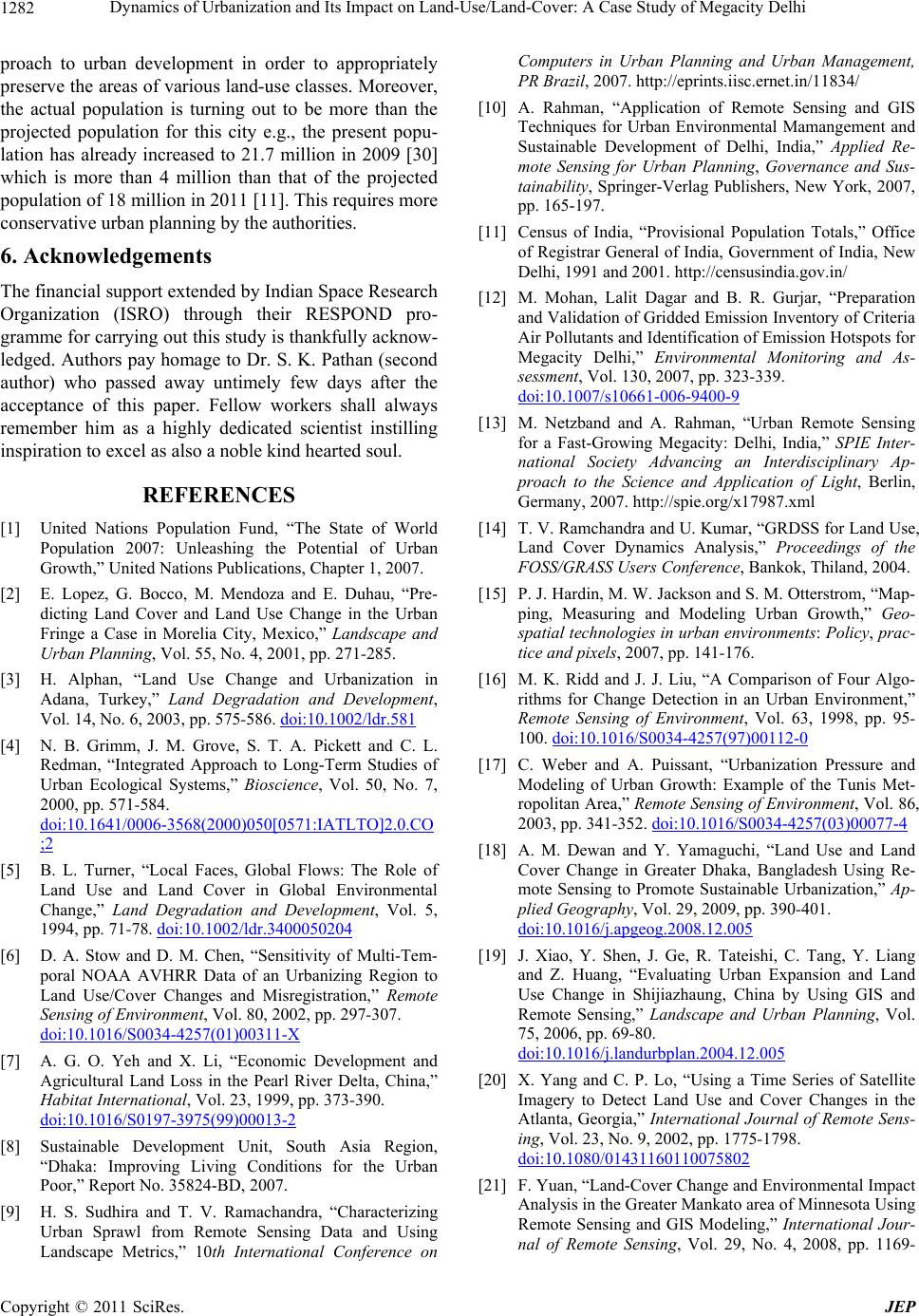
Dynamics of Urbanization and Its Impact on Land-Use/Land-Cover: A Case Study of Megacity Delhi
1282
proach to urban development in order to appropriately
preserve the areas of various land-use classes. Moreover,
the actual population is turning out to be more than the
projected population for this city e.g., the present popu-
lation has already increased to 21.7 million in 2009 [30]
which is more than 4 million than that of the projected
population of 18 million in 2011 [11]. This requires more
conservative urban planning by the authorities.
6. Acknowledgements
The financial support extended by Indian Space Research
Organization (ISRO) through their RESPOND pro-
gramme for carrying out this study is thankfully acknow-
ledged. Authors pay homage to Dr. S. K. Pathan (second
author) who passed away untimely few days after the
acceptance of this paper. Fellow workers shall always
remember him as a highly dedicated scientist instilling
inspiration to excel as also a noble kind hearted soul.
REFERENCES
[1] United Nations Population Fund, “The State of World
Population 2007: Unleashing the Potential of Urban
Growth,” United Nations Publications, Chapter 1, 2007.
[2] E. Lopez, G. Bocco, M. Mendoza and E. Duhau, “Pre-
dicting Land Cover and Land Use Change in the Urban
Fringe a Case in Morelia City, Mexico,” Landscape and
Urban Planning, Vol. 55, No. 4, 2001, pp. 271-285.
[3] H. Alphan, “Land Use Change and Urbanization in
Adana, Turkey,” Land Degradation and Development,
Vol. 14, No. 6, 2003, pp. 575-586. doi:10.1002/ldr.581
[4] N. B. Grimm, J. M. Grove, S. T. A. Pickett and C. L.
Redman, “Integrated Approach to Long-Term Studies of
Urban Ecological Systems,” Bioscience, Vol. 50, No. 7,
2000, pp. 571-584.
doi:10.1641/0006-3568(2000)050[0571:IATLTO]2.0.CO
;2
[5] B. L. Turner, “Local Faces, Global Flows: The Role of
Land Use and Land Cover in Global Environmental
Change,” Land Degradation and Development, Vol. 5,
1994, pp. 71-78. doi:10.1002/ldr.3400050204
[6] D. A. Stow and D. M. Chen, “Sensitivity of Multi-Tem-
poral NOAA AVHRR Data of an Urbanizing Region to
Land Use/Cover Changes and Misregistration,” Remote
Sensing of Environment, Vol. 80, 2002, pp. 297-307.
doi:10.1016/S0034-4257(01)00311-X
[7] A. G. O. Yeh and X. Li, “Economic Development and
Agricultural Land Loss in the Pearl River Delta, China,”
Habitat International, Vol. 23, 1999, pp. 373-390.
doi:10.1016/S0197-3975(99)00013-2
[8] Sustainable Development Unit, South Asia Region,
“Dhaka: Improving Living Conditions for the Urban
Poor,” Report No. 35824-BD, 2007.
[9] H. S. Sudhira and T. V. Ramachandra, “Characterizing
Urban Sprawl from Remote Sensing Data and Using
Landscape Metrics,” 10th International Conference on
Computers in Urban Planning and Urban Management,
PR Brazil, 2007. http://eprints.iisc.ernet.in/11834/
[10] A. Rahman, “Application of Remote Sensing and GIS
Techniques for Urban Environmental Mamangement and
Sustainable Development of Delhi, India,” Applied Re-
mote Sensing for Urban Planning, Governance and Sus-
tainability, Springer-Verlag Publishers, New York, 2007,
pp. 165-197.
[11] Census of India, “Provisional Population Totals,” Office
of Registrar General of India, Government of India, New
Delhi, 1991 and 2001. http://censusindia.gov.in/
[12] M. Mohan, Lalit Dagar and B. R. Gurjar, “Preparation
and Validation of Gridded Emission Inventory of Criteria
Air Pollutants and Identification of Emission Hotspots for
Megacity Delhi,” Environmental Monitoring and As-
sessment, Vol. 130, 2007, pp. 323-339.
doi:10.1007/s10661-006-9400-9
[13] M. Netzband and A. Rahman, “Urban Remote Sensing
for a Fast-Growing Megacity: Delhi, India,” SPIE Inter-
national Society Advancing an Interdisciplinary Ap-
proach to the Science and Application of Light, Berlin,
Germany, 2007. http://spie.org/x17987.xml
[14] T. V. Ramchandra and U. Kumar, “GRDSS for Land Use,
Land Cover Dynamics Analysis,” Proceedings of the
FOSS/GRASS Users Conference, Bankok, Thiland, 2004.
[15] P. J. Hardin, M. W. Jackson and S. M. Otterstrom, “Map-
ping, Measuring and Modeling Urban Growth,” Geo-
spatial technologies in urban environments: Policy, prac-
tice and pixels, 2007, pp. 141-176.
[16] M. K. Ridd and J. J. Liu, “A Comparison of Four Algo-
rithms for Change Detection in an Urban Environment,”
Remote Sensing of Environment, Vol. 63, 1998, pp. 95-
100. doi:10.1016/S0034-4257(97)00112-0
[17] C. Weber and A. Puissant, “Urbanization Pressure and
Modeling of Urban Growth: Example of the Tunis Met-
ropolitan Area,” Remote Sensing of Environment, Vol. 86,
2003, pp. 341-352. doi:10.1016/S0034-4257(03)00077-4
[18] A. M. Dewan and Y. Yamaguchi, “Land Use and Land
Cover Change in Greater Dhaka, Bangladesh Using Re-
mote Sensing to Promote Sustainable Urbanization,” Ap-
plied Geography, Vol. 29, 2009, pp. 390-401.
doi:10.1016/j.apgeog.2008.12.005
[19] J. Xiao, Y. Shen, J. Ge, R. Tateishi, C. Tang, Y. Liang
and Z. Huang, “Evaluating Urban Expansion and Land
Use Change in Shijiazhaung, China by Using GIS and
Remote Sensing,” Landscape and Urban Planning, Vol.
75, 2006, pp. 69-80.
doi:10.1016/j.landurbplan.2004.12.005
[20] X. Yang and C. P. Lo, “Using a Time Series of Satellite
Imagery to Detect Land Use and Cover Changes in the
Atlanta, Georgia,” International Journal of Remote Sens-
ing, Vol. 23, No. 9, 2002, pp. 1775-1798.
doi:10.1080/01431160110075802
[21] F. Yuan, “Land-Cover Change and Environmental Impact
Analysis in the Greater Mankato area of Minnesota Using
Remote Sensing and GIS Modeling,” International Jour-
nal of Remote Sensing, Vol. 29, No. 4, 2008, pp. 1169-
C
opyright © 2011 SciRes. JEP